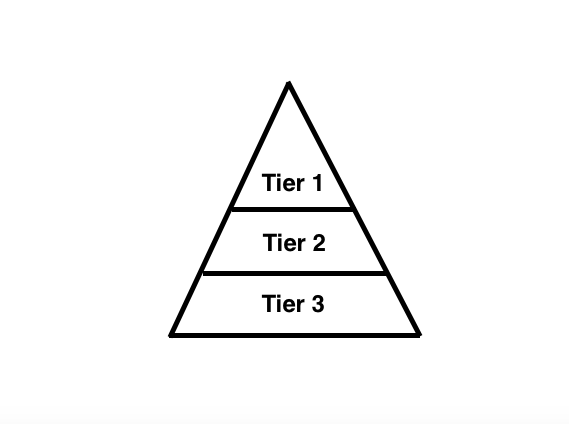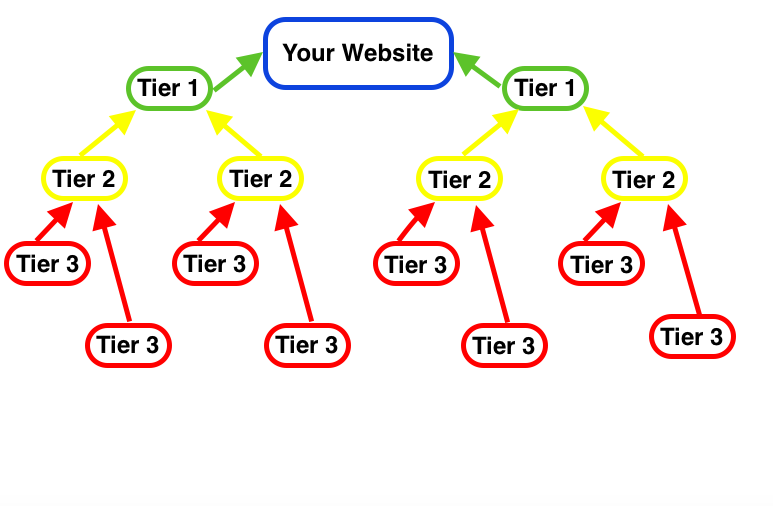How to Start Building a Tiered Backlink Pyramid
- Created at:
- Updated at:
Creating a backlink pyramid is a type of SEO strategy that helps to increase domain authority and generate traffic to your website. From the very beginning, this approach seems a bit time-consuming. It might be true; however, its implementation is definitely worth the resulting outcome.
The backlink pyramid is also known as tiered link building. This strategy usually implies three levels of backlinks where the highest one corresponds to Tier 1, and the lowest one stands for Tier 3.

As visible from the picture, each successive level supports the one above. Thus, the backlinks from the Tier 2 reinforce the effect of the pages with backlinks on Tier 1. While the Tier 3 backlinks serve as a basis for Tier 2, increasing the authority of pages on the second level.
What is the backlink pyramid structure?
The primary purpose of the backlink pyramid is to support the pages with the links coming to your website. The impact of tiered backlinking is like the geometric progression effect, where the numbers get higher with each step. Consequently, the traffic is expected to grow in a similar way.
While the overall structure of the backlink pyramid is pretty much clear, the establishment of each layer requires an individual approach. Below find detailed information about tires along with their development and maintenance.

- Tier 1
The backlinks at this level are considered to be the best and the most quality ones. They may come from credible websites with high domain authority. You might also consider writing a guest post and insert the backlink to your website from there. Overall, the backlinks on Tier 1 should be similar to those you gain within a typical outreach strategy.
There might be lots of links coming directly to your website from other pages; however, you need to consider the best ones to place them on the pyramid top. It is recommended to choose around 2-3 links at this stage. You might choose more but keep in mind that the number of backlinks on lower levels will significantly increase due to this. It means that more time and effort would be needed for building a proper tiered backlink pyramid.
- Tier 2
At this point, the quality and quantity of backlinks would be different from that on the highest level. Ideally, there should be around 8-12 links supporting each backlink on Tier 1. For example, if you have 3 backlinks at the top level, there should be around 30 backlinks within Tier 2. The backlinks on Tier 2 are supposed to strengthen the authority of Tier 1 backlinks.
As for the quality, the backlinks on the second layer should not be top-notch. When creating the middle tier of links, consider forums, blogs, social media pages as the places to start from. Posting comments on such platforms will not cost you much time and effort.
Consider manual backlinking at this stage as it will pay you off later even though it seems exhausting from the beginning. Google and other search engines would appreciate this because they are prone to detect the automation traces right away.
- Tier 3
Once you are ready with the second tier of backlinks, it is the right time to take a short break. During this pause, think of the best way to build the basis of your backlink pyramid. For Tier 3, you will need to create and maintain an enormous number of links.
It is recommended to have around 10 backlinks on Tier 3 for each page on Tier 2 to strengthen them properly. In case you have 30 backlinks in the middle layer, that will result in around 300 links on Tier 3 during this phase.
Consider various methods that would help you to save time and preserve a decent quality of backlinks. For instance, partner programs and backlinking services linksmanagement.com would be the right choice for you. Using automation tools might be also an option, but think twice before going into that as search engine algorithms become smarter each day.
Benefits of tiered backlinking
Before exploring the advantages of the tiered backlink pyramids, it is essential to refer to the regular link building strategies. In general, when other online sources contain the links leading to your web pages, this positively influences the rating and reputation of your website.
- Enhancing domain authority
Even though link building goes beyond the on-page SEO tactics, webmasters may obtain enough control over that. Many companies put the link building strategy on the list of SEO plan. According to the recent statistics announced by Backlinko, the number of domains linking to a page was the factor with the highest correlation to rankings in Google. Gaining more and more links over time helps keep the ball rolling and gradually enhances the domain authority.
When it comes to tiered backlinking, the overall result is multiplied due to the significant number of links. It means that not only your website’s domain authority is enhanced but also the rating of websites on other tiers is improved. This happens due to the recursive logic of tiered backlinking when one object is directly dependent on the previous one.
- Saving time
If you already have the links coming to your website from other credible sources, this is a good starting point for building a tiered pyramid. When there are enough backlinks on Tier 1 and you are satisfied with their quality, you may start the Tier 2 creation.
- Boosting traffic
With the backlink pyramid, the traffic to your website is increasing drastically. Google or other search engines rank your website higher so that more visitors will be able to see it. Also, the page visit numbers are growing organically as there are users naturally coming from other sources linking to your page.
Risk of the backlink pyramid implementation
The creation of the tiered pyramid might seem risky due to its complexity. However, acknowledging the probable threats might help you to craft the entire strategy properly.
- The quality of backlinks
The excellent links are associated with Tier 1, however, disregarding the quality of the backlinks at Tier 2 and Tier 3 is not something you should do. Read more about how to determine the backlink quality and its impact on your performance. Knowing that will help you to avoid spammy or unnecessary backlinks
- Google algorithms are getting smarter
Every year, Google crawl bots and search algorithms are getting more sophisticated. It is not only about Google but other search engines which regularly improve their techniques for ranking websites. Also, Google won’t tolerate automated link building and might penalize your website as a result.
Apart from the automatic approaches, search engines have the manpower that checks web pages manually. If an agent notices some suspicious link building techniques used, this might also influence your website rankings.
Even though search engines will detect something wrong, you can always step back. There is a positive aspect of the backlink pyramid - you may remove the backlinks from Tier 2 at any time. This will cut off the chain leading to your main website.
The future of backlink pyramids
We need to acknowledge that the pace of web development and technology is abundant. While barely anyone heard of SEO in the late 1990s, new SEO strategies appear regularly in the 2020s. It is safe to say that backlinking, including tiered backlinking, has been one of the top factors influencing website ranking for a long time already and will continue doing so at least for the next several years.
Communication Manager
Popular posts
-
Is Your Website Ready for These 28 Types of DDoS Attacks?
- 1
- 0
-
Blog ideas: Topics and examples to get you started
- 0
- 0
-
Most Common Causes for Customer Returns from Online Orders
- 4
- 0
-
Using Open edX: Definitive guide
- 0
- 0
-
5 ways to market your physical therapy clinic
- 0
- 0
-
Comparium Review - The Web-Based Testing Solution
- 3
- 0
